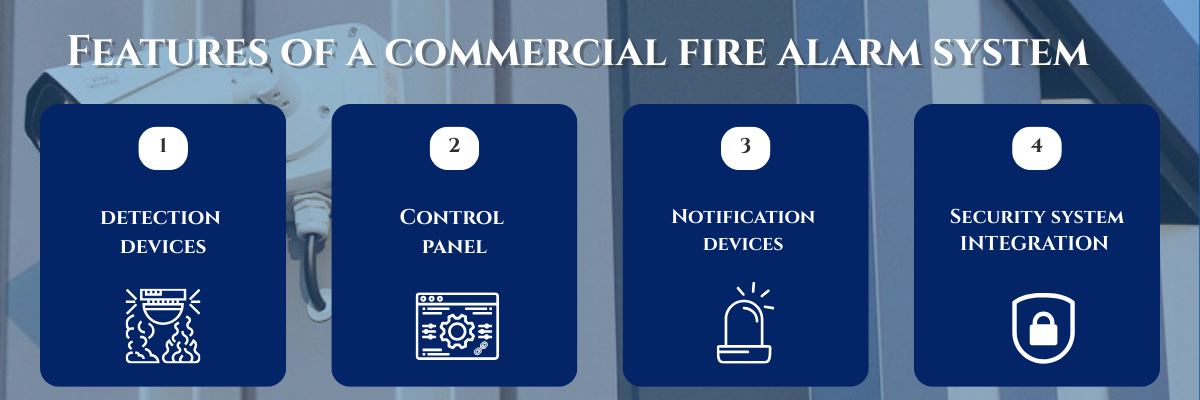What is commercial fire alarm system installation?
Commercial fire alarm installation is a comprehensive process that includes the design, setup, and ongoing maintenance of fire detection and alert systems within business premises.
These systems consist of multiple components, such as smoke detectors, manual call points, audible and visual alarms, and central control panels, and can often be integrated with other security and building management systems.
More complex, scalable, and integrated than domestic systems, commercial fire alarms often require more sensors and additional protections.
Such advanced protections can include sprinkler systems, visible alarms, automatically shutting doors in different zones, powering off ventilation and air conditioning, and even redirecting elevators to bring cars to a designated safe floor.

Commercial fire alarm installation by Protive
At Protive, we provide a complete turnkey service for commercial fire alarm installation, tailored to the specific needs of your premises and industry.
From an initial site inspection and system design to commercial smoke detector installation, ongoing monitoring, and maintenance, we’ll ensure your business is protected and compliant with UK fire safety regulations.
Our expert engineers design, install, and maintain advanced fire detection technologies, including wireless and addressable fire alarm systems, integrated smoke detectors, and multi-sensor solutions.
As a trusted commercial fire alarm monitoring company, we can also provide effective monitoring solutions that support the detection of risks in real time, ensuring a rapid response to protect people, property, and critical operations.
Whether you require new system installation, upgrades to existing infrastructure, or ongoing monitoring and maintenance support, Protive delivers reliable, scalable, and compliant fire safety solutions for commercial environments.
Request a no-obligation quote today
Why choose a professional commercial fire alarm installer?
Given commercial fire alarms are complex systems that must be fail-safe and adhere to the most recent regulatory requirements (including British Standards BS 5839-1), using individuals who are not qualified to install them increases the risk of safety issues and non-compliance with these standards.
Potential consequences of non-compliance can include penalties, invalidated insurance policies, and, crucially, loss of lives in the event of a fire.
The only way you can be confident in the design, installation, and maintenance of your alarm system is to enlist expert help from one of the dedicated commercial fire alarm installation companies that appear on the BAFE Fire Safety Register.
An experienced, compliant, and accredited operator in the field, Protive can provide a comprehensive service consisting of the design, installation, testing, maintenance, monitoring, and certification of commercial fire alarm systems.
Commercial fire alarm installation near me
Searching online for ‘commercial fire alarm systems installation near me’?
With offices in Warrington, Merseyside, and Cannock, our team is strategically positioned across the UK, enabling us to support businesses with their commercial fire alarm installation needs, no matter their location.
FAQs
Do I need a fire alarm in my business premises?
Yes, in line with the most relevant fire safety regulations – the Regulatory Reform (Fire Safety) Order 2005 - it’s a legal requirement in the UK for all non-domestic and commercial properties to (where appropriate) be equipped with fire detectors and fire alarms.
On top of being a legal necessity, many insurance providers will also require you to have a fire alarm system in place to benefit from policy cover.
Do I need maintenance after installation?
Yes, part of the legal requirements of having a fire alarm in a commercial building is to also ensure it is properly maintained and ready to activate in the event of a fire.
What type of system do I need?
The most effective system for your commercial property will depend on a variety of factors. This includes the size of your business, the number of occupants in the building, and whether you undertake any high-risk business activities, such as cooking or manufacturing.
How much will it cost?
The cost to install a commercial fire alarm system in the UK varies significantly, typically ranging between £1,500 and £10,000 or more.
However, the exact commercial fire alarm system installation cost will depend on the property size, system complexity, and whether any specialised components are required.
For example, smaller, simpler commercial properties in lower risk environments, such as small offices and shops, only need a basic fire alarm system, which tends to cost between £1,500 and £3,000.
Larger commercial buildings with specific risk factors, on the other hand, like warehouses, hospitals, and industrial sites, are more likely to require complex fire alarm systems with sophisticated detection equipment, increasing costs to between £7,500 and £20,000+.
How long does installation take?
The property's size, complexity, and system type will all dictate how long commercial fire alarm system installation takes. Smaller, simpler systems can be installed in a matter of hours, while more complex ones can take several weeks.
For a more accurate idea of how long commercial fire alarm installation will take for your business, please don’t hesitate to request a no-obligation quotation from our team.
What standards do you comply with?
Protive Security Group is accredited BAFE SP203-1 which covers Fire Detection and Fire Alarm Systems.
This scheme exists to deliver quality, independent evidence that providers are competent to deliver design, installation, commissioning and/or maintenance fire detection and fire alarm system services.

